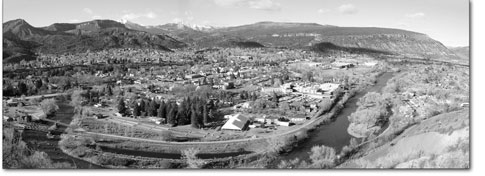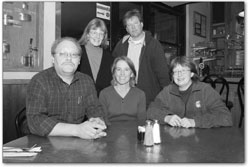| ||||
| Getting with the grassroots Independent group seeks long-term vision for the area SideStory: Becoming a visionary
by Missy Votel As the City of Durango works to retool its 1997 Comprehensive Plan, a grassroots effort to define a long-term vision for the region has taken root. Katherine Holt and Kathy Turner came up with the idea for the Grassroots Vision Project after attending city-sponsored scoping meetings on the comp plan last year. “Kathy and I had been interested in what the city was doing,” said Holt. However, after attending two visioning workshops, one in March and one in November, the two were frustrated with the outcome. “It didn’t seem like the visioning process went far enough. What came out of it seemed more like a list of priorities than a vision for the future,” said Holt. “A vision is important, and knowing where we want to be in the future can help in making choices in moving toward that vision.” Aside from being concerned about the nature and scope of the visioning process, the women also were concerned that the public meetings didn’t draw a broad enough cross-section of citizens. As a result, they launched their own effort with a kick-off meeting last December that drew about 30 interested people. The two women, who work as independently as consultants and came together as “concerned citizens,” decided to conduct more in-depth visioning interviews. The surveys would use a technique called “appreciative inquiry,” in which both women are trained. According to Turner, the method gauges people’s feelings by focusing on the positive and what works, versus placing blame and looking at the negative. “The process involves identifying what’s best about living in La Plata County and what we want more of in the future,” she said. According to Holt, more action results from using such a method. “When people focus on the positive, they are much more energized in making the vision come true.” Although the process does not focus on the problems of the area, such as growth, Turner noted that it does not overlook them, either. Instead, the process views problems as opportunities. “Growth is here to stay, and we need to manage it,” she said. “We’re not ignoring what’s bad but reframing it in the way we want to go.” So far, the group has received more than 130 completed surveys via its website, conducted 30 interviews and trained 20 people to conduct interviews. Three more training sessions will be held throughout the county in the upcoming week, and several volunteers have stepped forward to form a steering committee that will oversee the project. The group will be holding monthly meetings to coincide with the timing of the city’s visioning process so input from those meetings may be shared with the city. Information from surveys and interviews collected through Jan. 13 will be used at the first meeting, a visioning summit this Saturday at the Durango Recreation Center. Participants will look at common themes, discuss what a 100-year legacy might entail, and begin drafting a vision statement. A second summit, on Feb. 18, will look at further survey analysis and work on crafting the vision. A third summit, on March 18, will design action steps to implement the vision. After that, the group will meet quarterly for progress reports and discussing ways to further implement plans. According to Turner, a 30-year resident, word on the project has spread quickly, mostly via word of mouth4 and fliers. “I e-mailed 80 people and encouraged them to e-mail their friends,” she said. “I think it has the possibility to spread like wildfire.” In addition to contacting people they know, Turner and Holt also have sought input from nearly 30 stakeholder groups in the community that normally do not attend city meetings or aren’t involved in the planning process. Such groups include rancher/farmers, the elderly, students, nonprofit groups, and the Latino and Native American communities. For example, the group had a table at the La Plata Unity Coalition’s “Community Dialogue and Minority Services Fair” at Miller Middle School, held earlier this week.
“We’re getting the heard and the unheard populations – the more, the better,” Turner said. “That way, we can figure out what are our common themes for the future.” Along the same lines, the project also is reaching out to county residents, not just city dwellers. In addition to a meeting in Durango this Saturday, the group also is making a countywide push with training sessions in Bayfield and Ignacio. “We wanted to go beyond the city, since the city and county are linked geographically and socially,” said Holt. “Coming up with a vision for the region just makes sense.” The group is not just looking beyond city limits, but beyond this century. “We’re focused on 2030 and what we’d like to see for the region, and also what kind of 100-year legacy we might want,” said Holt. Turner was quick to point out that the object of the process is not to circumvent the city’s process but to augment it. She said that so far, city and county officials have been supportive of the process, with both groups exchanging information and ideas. “We’re trying to be as transparent and helpful as we can be,” said Holt. “We feel like we have a really nice collaborative situation.” Greg Hoch, Durango’s director of planning, agreed. “Rather than competing, we see it as a complementary process,” he said. Hoch added that he believes the work the group is conducting is valuable for several reasons. “Their visioning process is not only citywide, it’s countywide, which is something we couldn’t do,” he said. Furthermore, the grassroots vision is looking 100 years out, whereas the city is looking more to the immediate future of 25 years down the road. “There’s a limit to where we can go, versus where they can go.” He said one criticism of the group’s method it that is too idealistic. However, he noted that idealism has its place, and that he is open to learning what he can from the process. “Idealism in the right process can be good,” he said. “I believe they’re doing the right thing. Our objective is to take advantage of any information we have and using what we can.” In addition to collaborating with the city, the group also is keeping the lines of communication open with Operation Healthy Communities. That local organization examines trends and issues affecting Southwest Colorado and convenes an annual summit on such issues. Kim Newcomer, executive director of Operation Healthy Communities, said the results of both the grassroots and city’s visioning processes will likely dovetail into a topic at the summit. She said the summit will be useful in helping bring the Grassroots Vision Project, and thus action, to a larger audience. “That’s what the summit is all about: community input that results in community action.” And she noted that regardless of how the information is gathered, the important thing is that people are participating. “The important thing to know is that you can take part in any process you feel comfortable with – whether it’s through the grassroots project, the city’s workshops or our Summit Survey – and that these groups are all working together to get your voice heard.”
|



